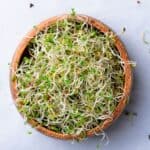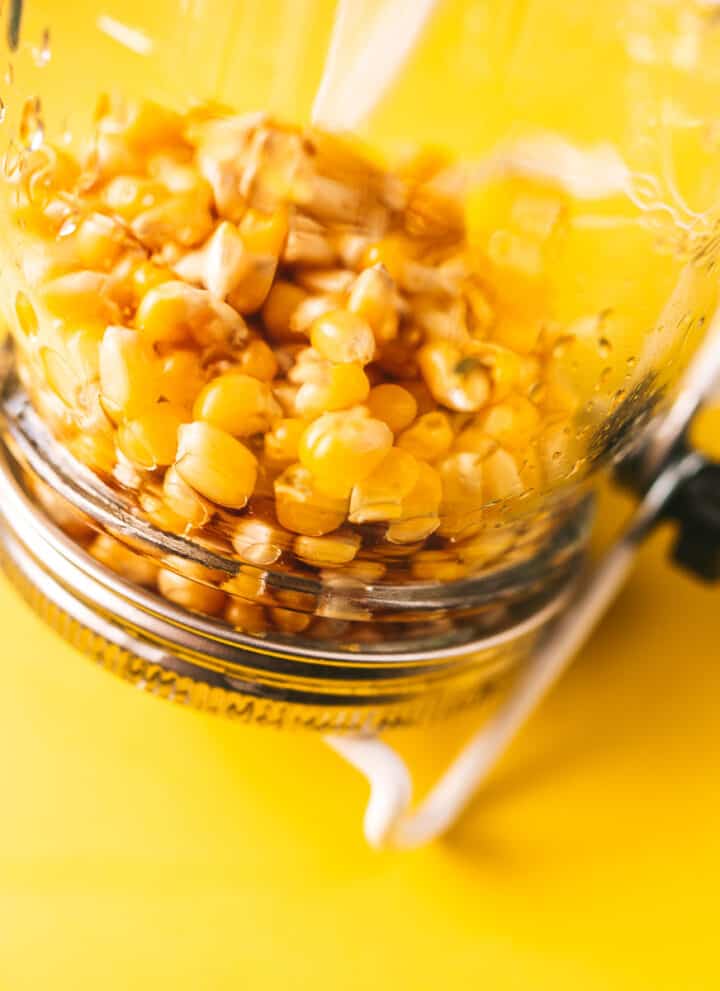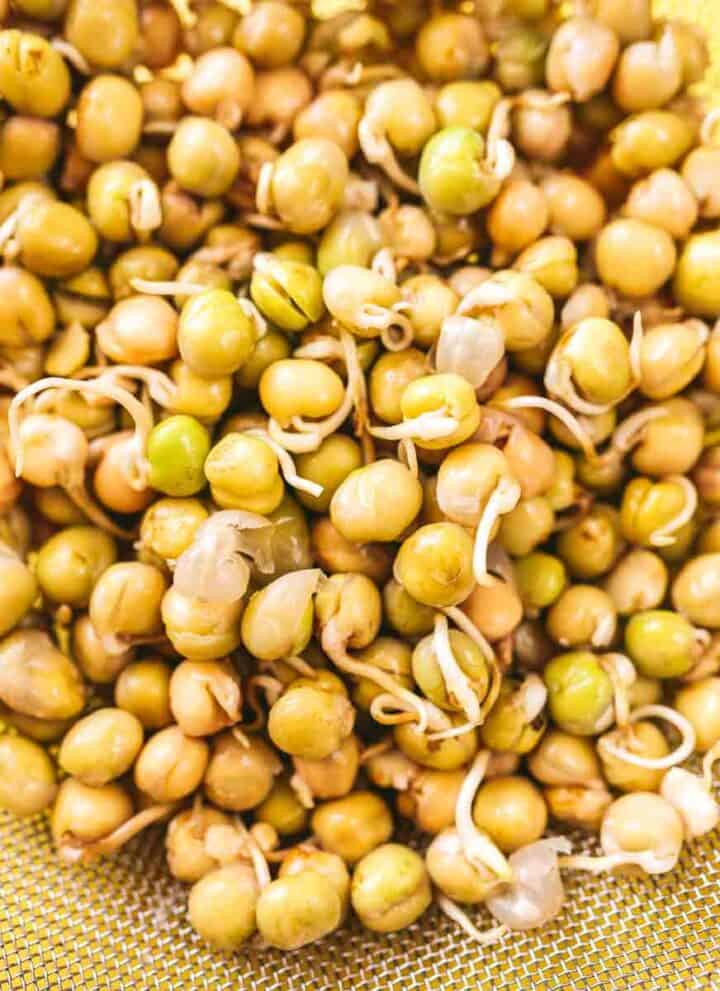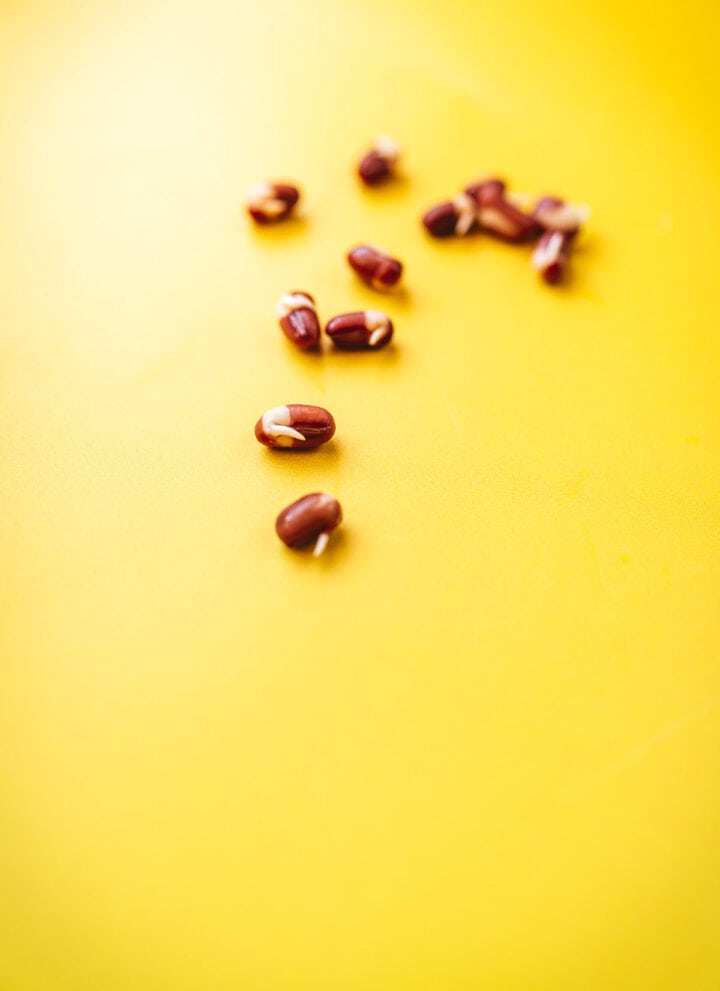Sprouted potatoes are a common sight in many households. While some people believe that they are safe to eat, others are skeptical about their safety. The question remains: can you eat sprouted potatoes?

According to Healthline, sprouted potatoes contain solanine and chaconine, which are natural toxins that can cause symptoms like nausea, vomiting, and diarrhea. While small sprouts may not pose a significant risk, significant sprouting could make you sick. Therefore, it is important to assess the risk before consuming sprouted potatoes.
Jump to:
All recipes suggest that sprouted potatoes that are still firm, have relatively small sprouts, and do not show any wrinkles or shriveling are okay to eat, as long as you cut off the sprouted parts and soft spots. However, if the entire potato is sprouted and shriveled up, then it is too far gone and should be tossed out.

Why Do Potatoes Sprout?
Potatoes are a type of tuber that can sprout when left in storage for too long. This is a natural process that occurs when the potato is trying to reproduce. The sprouts that emerge from the potato are actually the potato's attempt to grow new plants.
The sprouting process is triggered by a variety of factors, including temperature, humidity, and light. Potatoes that are stored in warm, moist environments are more likely to sprout than those stored in cooler, drier environments. Similarly, potatoes that are exposed to light will sprout more quickly than those that are kept in the dark.
Potatoes that are stored in a way that allows for air circulation are less likely to sprout than those that are stored in sealed containers. This is because air circulation helps to remove moisture from the potatoes, which can slow down the sprouting process.
While sprouting is a natural process, it can also be a sign that the potato is starting to go bad. As the potato sprouts, it may also begin to soften or develop a green tint. These are signs that the potato is no longer fit for consumption and should be discarded.
Overall, sprouting is a natural process that occurs when potatoes are left in storage for too long. While sprouted potatoes can still be eaten, it is important to remove the sprouts before consuming them.
Can You Eat a Sprouted Potato?
Potatoes are a staple food in many households, and they are usually stored for an extended period. When left in storage for too long, potatoes can begin to sprout, creating debate as to whether eating them is safe.
On one hand, some consider sprouted potatoes perfectly safe to eat with various health benefits, while others believe they can be harmful to human health. The truth is, that sprouted potatoes are still edible, but it depends on the condition of the potato.
The sprouts themselves are not toxic, but they do contain a high concentration of glycoalkaloids, which can cause a sharp, bitter taste. These compounds can also cause digestive symptoms, such as stomach pain, diarrhea, and vomiting if consumed in large amounts.
If a potato has sprouted, it is essential to inspect it carefully before consuming it. If the potato is firm to the touch, does not look too wrinkly and shriveled, and the sprouts are small, it is still safe to eat. However, if the potato is soft, wrinkled, or has large sprouts, it is best to discard it.
It is also important to note that green potatoes should not be consumed, whether they have sprouted or not. Green potatoes contain a high concentration of solanine, a toxic compound that can cause vomiting, diarrhea, and even death in severe cases.
In conclusion, sprouted potatoes are safe to eat as long as they are still firm to the touch, do not look too wrinkly and shriveled, and the sprouts are small. However, if the potato is soft, wrinkled, or has large sprouts, it is best to discard it.
It is also important to remember that when potatoes look green when you cut into it, toss it away immediately as they are toxic. Potatoes, specifically potato tubers, that are exposed to light naturally turn green due to the presence of chlorophyll, a harmless compound found in all green plants.
However, it's important to be cautious, as green potato tubers may also contain glycoalkaloids, which can be toxic if consumed in large quantities.

How To Sprout Potatoes
Sprouting potatoes is a natural process that can occur when potatoes are stored for an extended period. While sprouted potatoes are still safe to eat, some people prefer to remove the sprouts before consuming them. Here are a few steps on how to sprout potatoes:
- Choose the right potatoes: Not all potatoes are created equal when it comes to sprouting. Look for potatoes that are firm, smooth, and free from any blemishes or bruises. Avoid potatoes that are already sprouting, as they may be more difficult to work with.
- Store the potatoes in a cool, dry place: Potatoes should be stored in a cool, dry place away from direct sunlight like the cellar, cupboard, or pantry. A temperature between 45-50 degrees Fahrenheit is ideal for storing potatoes. Avoid storing potatoes in the refrigerator, as the cold temperature can cause the starch in the potatoes to turn into sugar, which can affect their taste and texture.
- Check the potatoes regularly: Check the potatoes regularly to see if they have started to sprout. Sprouts typically appear as small bumps or eyes on the surface of the potato. If you notice any sprouts, you can either remove them or allow them to continue growing.
- Remove the sprouts: If you decide to remove the sprouts, use a sharp knife or vegetable peeler to carefully cut them away from the potato. Be sure to remove the entire sprout, including the small root at the base.
- Use the potatoes: Once you have removed the sprouts, the potatoes are ready to use. You can cook them as you normally would, or store them in a cool, dry place until you are ready to use them.
By following these simple steps, you can sprout potatoes safely and easily. Whether you choose to remove the sprouts or leave them intact, sprouted potatoes can be a delicious and nutritious addition to your diet.
Sweet Potato Sprouts vs Regular Potato Sprouts
Sweet potato sprouts are different from regular potato sprouts in a few ways. While both types of sprouts are edible, sweet potato sprouts have a milder taste and a softer texture than regular potato sprouts. Additionally, sweet potato sprouts are not toxic, unlike regular potato sprouts, which can contain solanine, a harmful toxin.
Regular potato sprouts can also have a bitter taste and a tough texture, making them less desirable to eat. In fact, it is generally recommended to avoid eating regular potato sprouts altogether due to the risk of solanine toxicity.
On the other hand, sweet potato sprouts are not only safe to eat but can also be a nutritious addition to meals. They are rich in vitamins and minerals, including vitamin C, potassium, and fiber. Sweet potato sprouts can be consumed raw or cooked and can be added to salads, stir-fries, or even used as a topping for pizzas.
Overall, while both sweet potato sprouts and regular potato sprouts are edible, sweet potato sprouts are the safer and more palatable option.

How To Tell That Potatoes Are Bad
Potatoes are a staple food in many households, but they can go bad quickly. It is important to know how to tell when potatoes are no longer safe to eat. Here are some signs to look out for:
Sprouts
Potatoes that have sprouted are still safe to eat, but only if you remove the sprouts. The sprouts contain solanine, which is a toxic compound that can cause illness if ingested in large amounts. If the sprouts are small and easily removable, the potato is still good to eat. However, if the sprouts are large or the potato has started to shrivel and wrinkle, it is best to discard it.
Soft Spots
If you notice soft spots on the potato, it is a sign that it has started to rot. The soft spots are usually caused by bacteria or fungi that have invaded the potato. These spots can quickly spread to the rest of the potato, so it is best to discard it.
Mold
Mold is another sign that a potato has gone bad. If you notice any green or black spots on the potato, it is best to discard it. Mold can produce toxins that can cause illness if ingested.
Smell
If a potato has gone bad, it will emit a foul odor. If you notice a musty or rotten smell coming from the potato, it is best to discard it.
In summary, it is important to pay attention to the signs that potatoes are no longer safe to eat. Sprouts, soft spots, mold, and a foul odor are all signs that the potato has gone bad and should be discarded.
Color
Color can be a great indicator of spoilage. Green spots in potatoes caused by chlorophyll is considered harmless. However, the presence of chlorophyll in potatoes signifies an increased production of the glycoalkaloid solanine in the tubers. Solanine is a neurotoxin that can cause nausea, headaches, confusion, abdominal pain, fever, severe neurological issues, and even death if ingested in large quantities.
Can You Cook Sprouted Potatoes?
If you have sprouted potatoes in your pantry, you may be wondering if they are still safe to cook and eat. The short answer is yes, but there are some important things to keep in mind.
Firstly, it is important to remove the sprouts before cooking the potatoes in potato recipes. The sprouts contain a high concentration of compounds called glycoalkaloids, which can be harmful if consumed in large quantities. While cooking can reduce the glycoalkaloid levels, it is still best to remove the sprouts to minimize any potential health risks.
To remove the sprouts, simply use a paring knife or vegetable peeler to cut them away. Be sure to remove any green spots on the potato skin as well, as these can also contain glycoalkaloids.
Once the sprouts and green spots have been removed, the potatoes can be cooked as usual. Boiling, baking, and frying are all safe cooking methods for sprouted potatoes.
It is worth noting that sprouted potatoes may have a slightly different taste and texture than non-sprouted potatoes. They may also take longer to cook, so be sure to adjust your cooking times accordingly.
In summary, sprouted potatoes can be cooked and eaten safely as long as the sprouts and green spots are removed beforehand. While they may have a slightly different taste and texture, they are still a nutritious and versatile ingredient for a variety of dishes.

What To Do With Sprouted Potatoes
When potatoes start to sprout, it is an indication that they are past their prime and may not be suitable for consumption. However, it is still possible to salvage sprouted spuds and use them in various ways.
Cut off the Sprouts
The easiest way to use sprouted potatoes is to cut off the sprouts and any green parts. The green color is due to the presence of chlorophyll, which is harmless but can also indicate the presence of solanine, a toxic substance that can cause nausea, vomiting, and diarrhea if ingested in large quantities. Therefore, it is important to remove any green parts before using sprouted potatoes.
Cook Them
Cooking sprouted potatoes can also make them safe to eat. Boiling, baking, or frying can reduce the concentration of solanine in potatoes. In fact, some people prefer to use sprouted potatoes for making potato chips because the sprouts can add a unique flavor and crispiness to the chips.
Plant Them
If you have a garden, you can also plant sprouted potatoes and grow your own potatoes. Simply cut the sprouted potatoes into pieces, making sure that each piece has at least one sprout. Plant the pieces in soil with the sprouts pointing upwards and cover them with a layer of soil. Water the soil regularly and wait for the potatoes to grow.
Feed Them to Animals
If you have pets or farm animals, you can also feed them sprouted potatoes. However, it is important to note that feeding animals too many sprouted potatoes can also cause health problems due to the presence of solanine. Therefore, it is recommended to limit the amount of sprouted potatoes fed to animals.
In conclusion, sprouted potatoes can still be used in various ways, but it is important to take precautions and remove any green parts before using them. Cooking, planting, and feeding them to animals are some of the ways to use sprouted potatoes.


















Jake says
Was looking for this exact info about sprouted potatoes and this is so helpful! I especially had no idea about sweet potato sprouts vs regular potato sprouts. Thanks for all the great ideas for how to cook them and understanding when they're safe to eat. Great information!!
Kristen says
I'm so happy you found it helpful! Thank you for visiting. 🙂